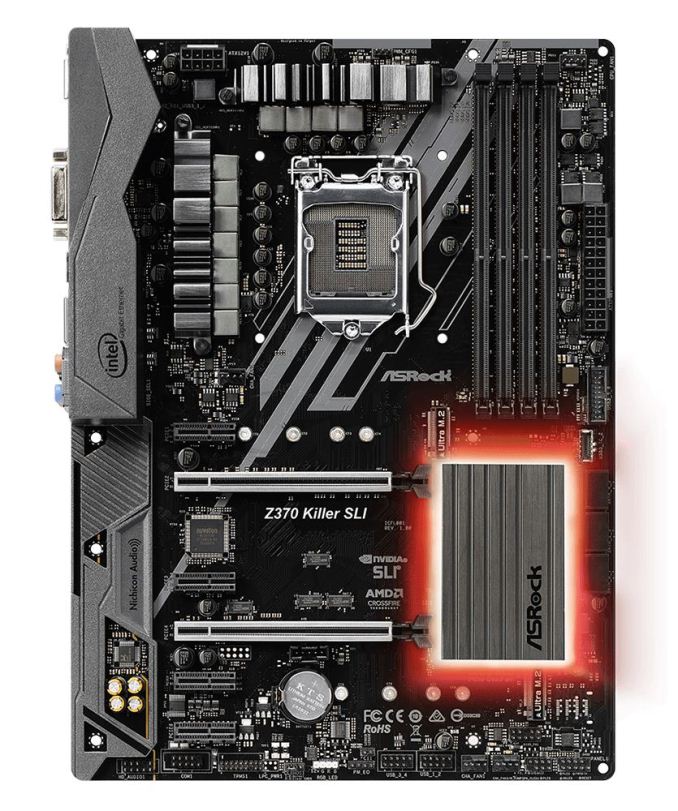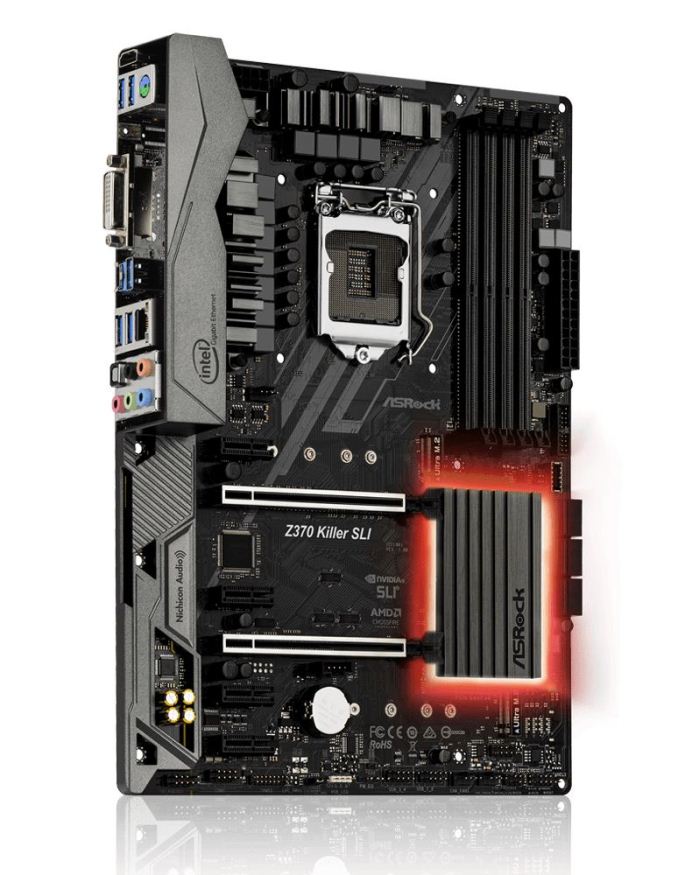Analyzing Z370 for Intel's 8th Generation Coffee Lake: A Quick Look at 50+ Motherboards
by Ian Cutress, Anton Shilov, Joe Shields & Gavin Bonshor on October 20, 2017 2:00 PM ESTASRock Z370 Killer SLI and Killer SLI AC
The ASRock Z370 Extreme line consists of the Z370 Killer SLI/ac, Killer SLI, and the Extreme4. Both of the Killer SLI boards will be covered on this page as the only difference between the two is the wireless LAN which comes with the SLI/ac. Some of the differences between the Gaming line and the Extreme line are the power delivery, different controllers/caps/chokes, different heatsinks, and controller choice allowing for cost-saving efforts to keep the price to the consumer lower than the Gaming or Professional branded motherboards.
Both the Killer SLI and SLI/ac look exactly the same outside of the back panel IO where the ac model has the Intel Wi-Fi card out back. The shared board otherwise is an all-black affair, outside of some artwork on the PCB going through the socket area. The chipset heatsink is more of a simple rectangle on the Killer boards compared to the Gaming boards, and has RGB LEDs below it. An RGB header is located on the bottom of the boards for adding another LED strip. Shrouding covers the back panel and audio sections, while the last design aesthetic that sticks out is the two full-length reinforced PCIe slots.
The four memory slots support the platform maximum of 64 GB, with supported speeds up to DDR4-4266. That value is still faster than most boards covered in the roundup, but one notch below the high-end ASRock boards. There are two full-length reinforced slots fed from the CPU, capable of x16 and x8/x8 connectivity, and four x1 slots from the chipset. Both 2-way SLI and 3-way Crossfire are supported (as well as quad SLI/Crossfire with dual GPUs).
The Killer SLI and SLI/ac both include six SATA ports supporting RAID 0, 1, 5, and 10. Additional storage is handled by two M.2 slots; the first is located above the top full-length PCIe slot and supports drives up to 80mm, while the second is located towards the bottom of the board below the chipset heatsink and supports drives up to 110mm. Be aware of slot sharing; if the first M.2 slot is occupied by a SATA device, SATA5 will be disabled, while if the second M.2 slot is occupied by a SATA module, SATA0 will be disabled.
Fan control is handled through the BIOS or via the F-Stream software, and gives control to all the fan headers: a CPU fan header (1A/12W), two chassis Fan headers, and a chassis optional/water pump header (1.5A/18W). Audio duties are handled by the last generation ALC892 codec, but is upgraded with the use of Nichicon Gold series audio caps. Network connectivity is handled by a single Intel I219-V on both boards with the SLI/ac adding the Intel Wi-Fi module for wireless support. The online specifications do not state which Wi-Fi module this is, although it is likely to be the AC3165.
USB connectivity is the same on both boards with neither utilizing the USB 3.1 (10 Gbps) controllers. On the back panel there are five USB 3.1 (5 Gbps) ports and one Type-C port. Additionally, there are two internal USB 2.0 headers supporting four ports, and another internal USB 3.1 (5 Gbps) header yielding two more ports. All USB ports are handled by the chipset. The back panel IO also has two video outputs with an HDMI and DVI-D port, as well as a 5 plug audio stack plus SPDIF. The Killer SLI/ac is the one with the Intel Wi-Fi antenna ports out back as well.















83 Comments
View All Comments
Hxx - Monday, October 23, 2017 - link
no they're not. the gigabyte gaming 5 is $200 the gaming 7 is $250 (just so happen I was looking at some gigabyte boards). Those prices are as high as z270 when it came out. In comparison, you could get a z270 gaming 7 for like 150. That's just one example I'm sure there are others. There is definitely a premium built into these boards for something that is nothing more than a stop gap and that will become obsolete 6 months from now.Hixbot - Sunday, October 22, 2017 - link
Only one board with 10GBE? That's dissapointing.pvdw - Sunday, October 22, 2017 - link
I'd really like reviews of the mITX boards, particularly the ASRock Z370 Gaming-ITX/ac. I'll be building a portable gaming + workstation to go in this case when it comes in January: https://www.kickstarter.com/projects/33753221/dan-...Thanks!
pvdw - Sunday, October 22, 2017 - link
mITX -> ITXTwister292 - Sunday, October 22, 2017 - link
The Aorus Gaming 5's M.2 slots are actually 2x110mm and 1x80mm accoding to the manual. It's also visible...the M2 slot at the top and the middle slot have 4 positions for the screws, the bottom slot has only 3.takeshi7 - Monday, October 23, 2017 - link
Asus, stop putting electrolytic capacitors on your TUF boards. The main reason I buy TUF boards is for the all solid caps. I don't care about "Nichicon gold" audio caps, and anyone who's serious about audio will have an external DAC or another sound card anyways. STAHHHP!Samus - Monday, October 23, 2017 - link
Having a "quick look" at 50 motherboards is somewhat an oxymoron, isn't it?tezpez - Tuesday, October 24, 2017 - link
May have spotted an error in the article - Asus Strix 370-F doesn't have wifi, whereas this page says it does: https://www.anandtech.com/show/11860/z370-motherbo...number58 - Tuesday, October 24, 2017 - link
The pictures for the Gigabyte Z370 Gaming K3 are actually some MSI mini itx board.pjcamp - Tuesday, October 24, 2017 - link
No, question 1 is "do I give 2 sh!ts about gaming?" How about a little help for people who are NOT twitch fanatics?